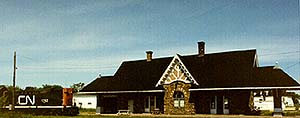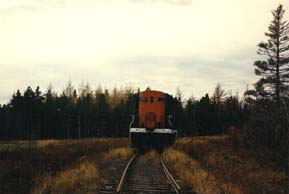








 While
the last Island engine had rolled into the ferry boat in
1989, much to the disappointment of local railway
devotees, the "moving of old 1762" gave them a
chance to revisit and celebrate their passion for the
railroad. The diesel
locomotive 1762, which eventually
found its final resting place at Kensington station in
1990, was built in early 1960 by Montreal Locomotive
Works, as part of CN's final attempt to completely
dieselize their system. It was originally numbered 3859,
but when CN decided to upgrade branchline power, the
engine received some refitting and was renumbered 1762.
Reclassified from an RS-18 to a MR-14-C, the powerful
engine was an impressive feat of engineering, and bore
the trademark orange, black, and white paint of Canadian
National. This model was used in Eastern Canada
principally on through freights, but was also served
occasionally on wayfreight, secondary passenger runs, and
switching assignments. It began its career at the
Montreal Yard Diesel Shop, but arrived in the Maritimes
in the 1960's when it was reassigned to Moncton. After
twenty-six years of service, it was retired from active
duty in June 1986.
While
the last Island engine had rolled into the ferry boat in
1989, much to the disappointment of local railway
devotees, the "moving of old 1762" gave them a
chance to revisit and celebrate their passion for the
railroad. The diesel
locomotive 1762, which eventually
found its final resting place at Kensington station in
1990, was built in early 1960 by Montreal Locomotive
Works, as part of CN's final attempt to completely
dieselize their system. It was originally numbered 3859,
but when CN decided to upgrade branchline power, the
engine received some refitting and was renumbered 1762.
Reclassified from an RS-18 to a MR-14-C, the powerful
engine was an impressive feat of engineering, and bore
the trademark orange, black, and white paint of Canadian
National. This model was used in Eastern Canada
principally on through freights, but was also served
occasionally on wayfreight, secondary passenger runs, and
switching assignments. It began its career at the
Montreal Yard Diesel Shop, but arrived in the Maritimes
in the 1960's when it was reassigned to Moncton. After
twenty-six years of service, it was retired from active
duty in June 1986.
But in 1987, the announcement was made that the rail lines on the Island would be abandoned, and there was a very real risk that Engine 1762 was destined to become scrap metal. That is, if it was not for the perseverance of Summerside resident Lowell Huestis, a die-hard railway enthusiast. Realizing that the province was experiencing the end of an era, Huestis set out on a mission to ensure that an engine stayed on the Island as a living reminder of this great age. In 1988, with the help of the Summerside Chamber of Commerce, Engine 1762 was moved from the Summerside railyards to an area near his street, where he gave it several coats of new black paint. Unfortunately, not everyone shared his love and respect for the railway, and local vandals delivered constant setbacks to the restoration process.
Deciding that 1762 needed a new home, Huestis approached the Kensington Area Chamber of Commerce about the possibility of moving the engine to the historic Kensington station. A plan slowly but surely emerged, although buffeted on all sides by nagging doubts about the feasability of such a move. Some insisted that moving the engine would cost too much, and others asked who would be found to undertake such a challenge. Perhaps the most serious obstacle-- an insurmountable one, according to some-- was that many of the rails between Kensington and Summerside had already been removed, leaving some gaps in the line. Nevertheless, those committed to the project soldiered on, confident that sufficient will would discover some sufficient way. If optimism could move mountains, it could certainly move a train.
First of all, the use of some of the former rails was secured from the company contracted to pull up the railbeds-- Galaxy of West Lincoln Ltd. Next, the committee obtained permission to temporarily close a road in New Annan, where a large section of rail had been removed from the highway crossing. Another important piece of the puzzle came together when the group managed to bring aboard Art Lambe, a former CN worker from Emerald, whose railway savvy would be an invaluable resource. Lambe actually came out a 14 year retirement to participate in the project. Finally, a willing contractor was found in Albert Waugh and Sons Construction, who devoted considerable thought to the predicament of how to move a 125-ton engine and replace missing tracks.
 And then on Friday,
November 16, 1990, all the planning and calculation was
finally put to the test, as the Waugh company and a
volunteer work force of seventeen men set the wheels of
1762 in motion once more. Pushing with a large payloader,
they were able to roll the engine along without too much
difficulty, as the terrain from Summerside from New Annan
was quite level. But when they arrived in New Annan, they
encountered the stumbling block that-- in the eyes of
many-- made this trip an impossible one. A recent upgrade
of the road, undertaken after the closing of the trains,
had resulted in the railway crossing being completely
removed; there was apparently no way of getting the train
across without ruining thousands of dollars worth of
pavement. But the moving team came prepared: if there was
no track there, they would construct one. Using two
payloaders, they
And then on Friday,
November 16, 1990, all the planning and calculation was
finally put to the test, as the Waugh company and a
volunteer work force of seventeen men set the wheels of
1762 in motion once more. Pushing with a large payloader,
they were able to roll the engine along without too much
difficulty, as the terrain from Summerside from New Annan
was quite level. But when they arrived in New Annan, they
encountered the stumbling block that-- in the eyes of
many-- made this trip an impossible one. A recent upgrade
of the road, undertaken after the closing of the trains,
had resulted in the railway crossing being completely
removed; there was apparently no way of getting the train
across without ruining thousands of dollars worth of
pavement. But the moving team came prepared: if there was
no track there, they would construct one. Using two
payloaders, they  built up approach rails, lifted a portable track system
onto the road, and carefully hooked all the tracks
together. As an assembled crowd held their breath, the
train was guided over the road without even so much as a
hitch.
built up approach rails, lifted a portable track system
onto the road, and carefully hooked all the tracks
together. As an assembled crowd held their breath, the
train was guided over the road without even so much as a
hitch.
Its final obstacle now behind it, Engine 1762 rolled into Kensington station at approximately 4 o'clock p.m., much to the delight of the large crowd which had gathered there to celebrate its arrival. The grinding of the wheels on the magnificent engine nearly brought tears of joy to those who heard it, taking them back to former days when a train pulling into Kensington was an everyday occurrence. All in all, the effort involved in moving the train was a classic example of the old never-say-die spirit of the railway, where the train always went through, no matter what stood in its way. The arrival of the train in Kensington in the 1870s had ushered in an era of prosperity, where the town grew up around the workings of the railway station. While 1762 would never be pulling out of the station, its arrival also served as a symbol of the town's continued vitality. The heritage efforts at the train station have breathed new life into the core of the community, as the process of rediscovering our proud past has instilled a new confidence and hope about the possibilities the future holds.
